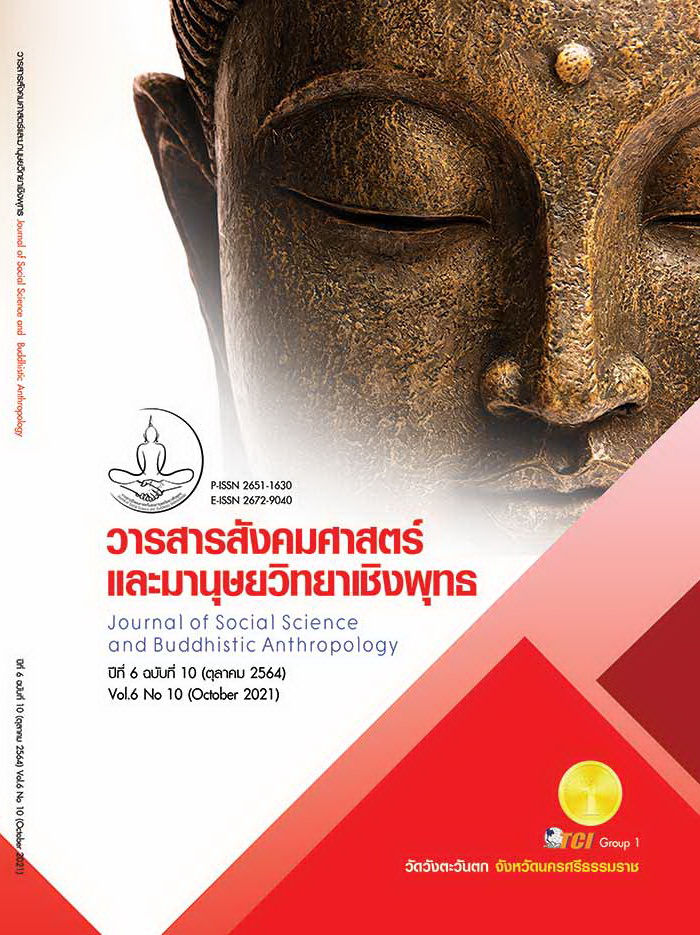A STUDY OF INNOVATIVE LEADERSHIP INDICATORS OF SMALL SCHOOL DIRECTORS UNDER THE OFFICES OF PRIMARY EDUCATIONAL SERVICE AREA IN THE NORTHEAST
Keywords:
Indicators, Innovative Leadership, DirectorsAbstract
The objectives of this research article were to study Indicators the innovative leadership of small size school directors under the offices of primary education service area in northeast. The qualitative methods research. The research process consisted of two steps: 1) study and synthesize documents, textbooks, principles, concepts, theories and related research; and 2) In - depth interviews, the main informants are school directors, education administrators and academics with 9 persons for content analysis and conclusion by purposive sampling from a semi - structured interview and analysis and synthesize documents by Miles & Huberman. The results showed that Innovative Leadership Indicators of Small School Administrators under the Primary Education Service Area Office In the northeastern region, it consists of 5 main components and 18 sub - components and 98 indicators as follows: 1) Innovative vision consists of 3 sub-components and 22 indicators as follows: creating a vision and strategy, implementing the vision, and disseminating the vision 2) Innovative creativity consists of 3 sub-components and 16 indicators as follows: initiative, flexibility and Imagination 3) Use of technology and communication consists of 4 sub-components and 20 indicators as follows: using technology in learning, ethical use of technology, use of technology in management and use Measurement and Evaluation Technology 4) Teamwork and participation consists of 4 sub-components and 20 indicators as follows: planning and setting common goals, communication, participation and building mutual trust, and 5) Creation of an innovative climate consists of 4 sub-components and 20 indicators as follows: motivation, promotion and support, appropriate organizational structure and innovative corporate culture.
References
กนกอร สมปราชญ์. (2559). ภาวะผู้นำและภาวะผู้นำการเรียนรู้สำหรับผู้บริหารสถานศึกษา. ขอนแก่น: โรงพิมพ์คลังนานาวิทยา.
จุรีวรรณ จันพลา. (2559). การเสริมสร้างภาวะผู้นำเชิงนวัตกรรมของผู้ประกอบการในธุรกิจแปรรูปอาหาร. วารสารเทคโนโลยีภาคใต้, 9(1), 53-60.
ชวลิตร เกิดทรัพย์ และคณะ. (2552). รูปแบบการพัฒนาภาวะผู้นำทางเทคโนโลยีการศึกษาสำหรับผู้บริหารโรงเรียน สังกัดสำนักงานคณะกรรมการการศึกษาขั้นพื้นฐานในภาคใต้. วารสารสงขลานครินทร์ (ฉบับสังคมศาสตร์และมนุษย์ศาสตร์), 15(1), 141-160.
ชาย โพสิตา. (2556). ศาสตร์และศิลป์แห่งการวิจัยเชิงคุณภาพ. กรุงเทพมหานคร: อมรินทร์พริ้นติ้ง.
ฐิตินันท์ นันทะศรี. (2562). การพัฒนาตัวบ่งชี้ภาวะผู้นำเชิงนวัตกรรมของผู้บริหารสถานศึกษาสังกัดสำนักงาน เขตพื้นที่การศึกษาประถมศึกษาในภาคตะวันออกเฉียงเหนือ. วารสารวิชาการและวิจัยสังคมศาสตร์, 14(3), 93-106.
สำนักงานรับรองมาตรฐานและประเมินคุณภาพการศึกษา (องค์การมหาชน). (2559). ก้าวข้ามขีดจำกัด สู่สหัสวรรษแห่งคุณภาพ สำนักงานรับรองมาตรฐานและประเมินคุณภาพการศึกษา (องค์การมหาชน). กรุงเทพมหานคร: สำนักงานรับรองมาตรฐานและประเมินคุณภาพการศึกษา (องค์การมหาชน).
สำนักงานเลขาธิการสภาการศึกษา. (2559). (ร่าง) กรอบทิศทางแผนการศึกษาแห่งชาติ พ.ศ. 2560 - 2575. กรุงเทพมหานคร: สำนักงานเลขาธิการสภาการศึกษา.
สุกัญญา แช่มช้อย. (2560). แนวคิดเชิงนวัตกรรมสำหรับการบริหารสถานศึกษาในศตวรรษที่ 21. วารสารศึกษาศาสตร์มหาวิทยาลัยนเรศวร, 14(2), 117-128.
อนุสรา สุวรรณวงศ์. (2562). คุณลักษณะของชุมชนแห่งการเรียนรู้ทางวิชาชีพในบริบทการศึกษาไทย. วารสารปัญญาภิวัฒน์, 5(2), 180-190.
อาภารัตน์ ราชพัฒน์. (2554). โมเดลสมการการพัฒนาตัวบ่งชี้ภาวะผู้นำครูในสถานศึกษาขั้นพื้นฐาน. ใน ดุษฎีนิพนธ์ปรัชญาดุษฎีบัณฑิต สาขาวิชาการบริหารการศึกษา. มหาวิทยาลัยขอนแก่น.
Boerner, S. et al. (2007). Follower behavior and organizational performance: the impact of transformational leaders. J Leaderh Org Stud, 13(3), 15-26.
Deschamps, J. & Nelson, B. (2014). Innovation Governance : How Top Management Organizes and Mobilizes for Innovation. USA: John Wiley & Sons.
Gliddon, D. G. (2006). Forecasting a competency model for innovation leaders using a modified delphi technique. In Doctoral dissertation. The Pennsylvania State University.
His - Chi, H. & Jen - Chia, C. (2011). The Role of organizational learning transformational leadership and organizational innovation. Asia Pacific Education Review, 12(4), 621-631.
Homan, M. & Miller, L. J. (2008). Critical Leadership Skills Key Traits That Can Make or Break Today’s Leaders. New Jersey: John Wiley & Sons.
Horth, D. & Buchner, D. (2014). Innovation leadership: How to use innovation to lead effectively, work collaboratively and drive results. Brussels Belgium: BNCC.
Jimenez - Jimenez, D. & Sanz - Valle, R. (2011). Innovation, organizational learning, and performance. J Bus Res, 64(4), 408-417.
Miles, M. B. & Huberman, A. M. (1984). Qualitative Data Analysis: A Sourcebook of New Methods. Beverly Hills: CA: Sage.
Oyvind, N. (2005). A beginner's guide to circuits : Nine simple projects with lights, sounds, and more / A. Bruce Carlson. San Francisco: No Starch.
Sashkin, M. (1988). Visionary leadership. In J. Conger, R. (ed.). Kananga and associates charismatic leadership: The elusive factor in organizational effectiveness (pp. 57-63). San Francisco: CA: Jossey - Bass.
Stillman, P. E. (2013). Emotional states from affective dynamics. Emotion Review, 5(4), 344-355.
Tidd, J. & Bessant, J. (2014). Strategic Innovation Management. United Kingdom: Wiley.








